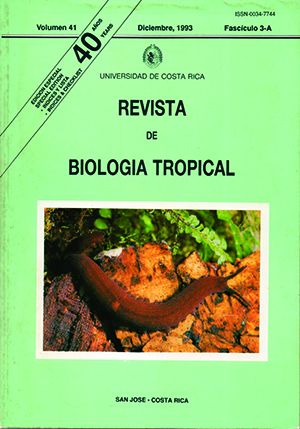Resumen
El comportamiento básico de Epiperipatus biolleyi Bouvier,1902 se estudió mediante experimentos de laboratorio usando 20 individuos. En pruebas de escogencia. prefirieron briófitos y su suelo, a gramíneas y su suelo. Se ocultaron principalmente entre la vegetación y raramente en la interfase o en el suelo. No parecen ser capaces de excavar sus propias madrigueras. Entran en ellas princ ipalmente caminando hacia adelante y muestran tendencia a descansar enfrentando la entrada, tal vez para responder con rapidez ante enemigos, presas y cambios climáticos. En 87 hr cambiaron de madriguera 2.89 veces. No se observó agresividad intraespecífica cuando había solo una madriguera. Cuando están en pares, la mitad de las veces descansan con algún tipo de contacto corporal. Se identificaron e ilustran siete posturas corporales básicas. Si se les coloca sobre musgo y se les expone a la luz solar, se ocultan en una media de 189 s. La velocidad de locomoción mostró medias individuales de 1.1- 1.3 cm/s. Flotan y se vuelven turgentes en agua dulce, pero perecen en agua de mar. S u sustancia adhesiva es amarga, se disuelve en menos de 3 s en agua marina y permanece líquida en agua dulce, lo cual apoya la hipótesis del secado qu ímico y no la del secado mecánico. En la naturaleza, los animales pueden tener cicatrices y oncopodios mutilados. Un ave (Turdus grayii ) y una serpiente (Micrurus hemprichii) son depredadores de otras especies de onicoforos en el campo. En cautiverio y con alimentación constante, E. biolleyi sobrevivió hasta 150 días. La agonía incluye retracción de las antenas y eliminación de saliva, sustancia adhesiva, heces yocasionalmente embriones prematuros. Las heces tienen gran cantidad de esférulas que podrían ser desechos metabólicos o bacttias tipo coco. Estos animales evitan las corrientes de aire y mudan cada IS días, aproximadamente.##plugins.facebook.comentarios##

Esta obra está bajo una licencia internacional Creative Commons Atribución 4.0.
Derechos de autor 1993 Revista de Biología Tropical
Descargas
Los datos de descargas todavía no están disponibles.


